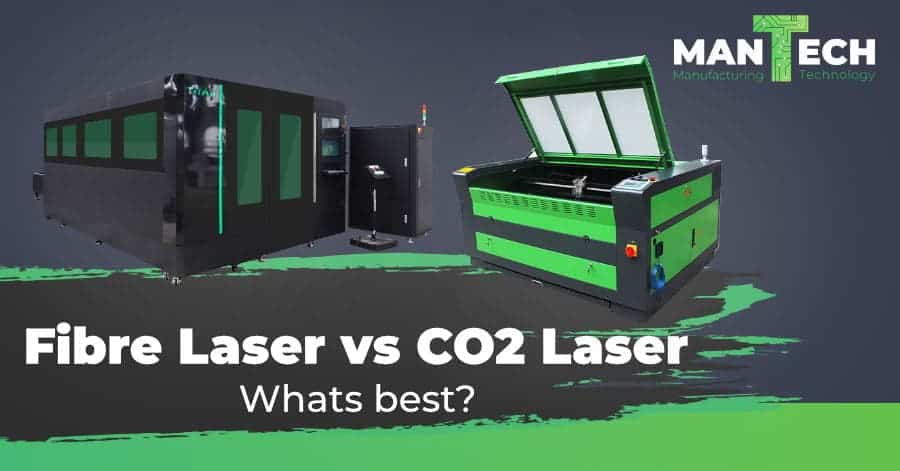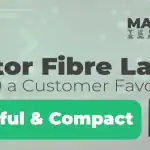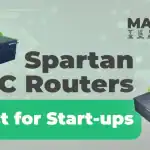Fibre Laser vs CO2 Laser

What are the main differences between a Fibre Laser and a CO2 Laser?
How do these machines work? Read on to find out.
Fibre & CO2 Laser Technology
With both technologies readily available as a manufacturing option for all types of industries these commonly used laser cutters operate in slightly different ways. Both fibre and CO2 lasers operate with different wavelength and powers, yet they are both extremely accurate methods of cutting.
Fibre Laser Cutters
Fibre lasers have been inherently used in manufacturing for many years but advances in technology and adoption has seen the costs for fibre drop to some of the most affordable levels to date. Typically suited to cutting metals such as mild and stainless steels they are also used to process aluminium, brass, copper and titanium. Offering high speed, accurate cutting and superior repeatability over more traditional methods of cutting metals. A fibre laser is generally found in powers of 500W and upwards like 1kW, 2kW, 3kW and 4kW etc.
Incredible at cutting thick metal projects with unrivalled accuracy and speed.
How do Fibre Lasers work?
There are similarities between CO2 and Fibre lasers in that thy both use a ‘source’ of power. That source is quite different, rather than use a laser tube and sets of mirrors to direct the beam onto your material, a fibre laser uses a fibre-optic cable to focus and intensify the beam through a focusing system before it hits your material. Since fibre laser sources can be anywhere from 500W to say 12kw for instance this will denote how thick you can cut, with the power ratings being much higher than a CO2 power source.
What is a fibre laser used for?
These really are the pinnacle of sheet (and tube) laser cutting that offer extremely high speed and performing precision and accuracy. Full continuous production capability is within your reach, in industries such as:
- General fabrication
- Aerospace
- Automotive
- Marine Engineering
- Construction
- Medical applications
- Homeware
With a fibre laser, a business can easily produce parts and products using materials such as:
- Mild steel
- Stainless Steel
- Brass
- Copper
- Aluminium
- Titanium
An in-depth look at fibre laser cutting principles
Fibre Laser Advantages
Speed
High-speed metal cutting at your fingertips.
Low Operator Maintenance
lower maintenance for the operator, for example, beam alignment, lens cleaning, bed aligning etc.
Excellent Energy Efficiency
Fibre lasers are more efficient in their use of energy as opposed to a CO2 laser machine.
One major disadvantage of a fibre laser
Cost. A fibre laser is generally more expensive due to the technologies and exceptional components used in the build of such a machine, but that performance does come at a cost (although the price is considerably more affordable than previous years). However, with that cost, comes the many benefits of using a fibre as mentioned above.
CO2 Laser Cutters
CO2 Laser Cutters are a firm favourite with so many different customers due to their versatility. From cutting to engraving (even engraving photos) on a wide range of materials, to their high accuracy, a laser cutter could be just what your business needs to help it rise to the next level of manufacturing.
Perfect for cutting and engraving materials such as card, paper, wood acrylics and so much more. Some models even come with rotary attachments to enable the user to engrave onto cylindrical products like glass tumblers. They won’t cut metal but you can opt for a metal/non metal (or as we call them Multi-Cut) CO2 laser that uses Oxygen as an assistive gas and 150W CO2 laser tube to pierce through thin metals as well as your normal laser cutter materials. See below:
CO2 Laser – Material Suitability Guide
See below for a quick guide showing you what can be processed with Laser Cutting & Engraving machines This list is not exhaustive however, there is an abundance of materials that can also be processed. Always check with your supplier if these materials are suitable for laser processing – materials such as *PVC can give off hydrochloric acid and toxic fumes, therefore it is not advisable that you attempt to process this or similar materials.
| MATERIAL | LASER ENGRAVE | LASER CUT |
|---|---|---|
| Natural Wood | ||
| Acrylic | ||
| Glass | ||
| Engraving Laminate | ||
| Bamboo | ||
| MDF | ||
| Leather | ||
| Cloth | ||
| Marble | ||
| Matte Boards | ||
| Stone | ||
| Paper | ||
| Mylar | ||
| Press Board | ||
| Rubber | ||
| Laser Plywood | ||
| Anodised/painted metal | ||
| Other plastics* | ||
| Ceramics | ||
CO2 Laser Advantages
- Laser Safety – all of our cabinet styled CO2 laser systems feature Safety Glasses, Proximity & Interlock Cabinets As Standard
- CO2 Laser Flexibility. The pure range of materials that can be processed on a CO2 machine is vast.
- Extremely accurate with precision cuts and engraving.
- Ease of use. With easy to use software and an abundance of tutorials in the public domain, a Lasertech CO2 Laser is easy to operate and learn.
CO2 Laser Disadvantages
- Operator maintenance is a little more involved – especially if the laser mirrors become misaligned if this happens you have to run through an adjustment procedure. However, once trained you will become quite adept.
- Generally do not cut metals unless you are using a special Multi-Cut machine that uses Oxygen as an assistive gas to pierce the metal.
- Extremely accurate with precision cuts and engraving.
How to Choose the right type of machine for you and your business
This is a fairly easy process to figure out. If your requirements are to process lots of metal plate and or pipe with high accuracy and speed Fibre lasers are the correct choice over most CO2 lasers (See CNC Plasma Cutters)
Should you mostly be looking to process materials of a non-metallic nature like wood, card leather and acrylics then a CO2 laser is likely to be the best choice for you. (See CNC Routers)
Mantech can provide you with impartial advice as to which machine would best suit your applications, if you feel you need to discuss this with one of our dedicated industry specialists, please contact us:
0121 541 1444 or email on sales@mantechmachinery.com
You can even request a quote from any of the product pages on our website.










